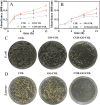Biological and structural properties of curcumin-loaded graphene oxide incorporated collagen as composite scaffold for bone regeneration
- PMID: 39634102
- PMCID: PMC11614606
- DOI: 10.3389/fbioe.2024.1505102
Biological and structural properties of curcumin-loaded graphene oxide incorporated collagen as composite scaffold for bone regeneration
Abstract
Introduction: To address the challenges related to bone defects, including osteoinductivity deficiency and post-implantation infection risk, this study developed the collagen composite scaffolds (CUR-GO-COL) with multifunctionality by integrating the curcumin-loaded graphene oxide with collagen through a freeze-drying-cross-linking process.
Methods: The morphological and structural characteristics of the composite scaffolds were analyzed, along with their physicochemical properties, including water absorption capacity, water retention rate, porosity, in vitro degradation, and curcumin release. To evaluate the biocompatibility, cell viability, proliferation, and adhesion capabilities of the composite scaffolds, as well as their osteogenic and antimicrobial properties, in vitro cell and bacterial assays were conducted. These assays were designed to assess the impact of the composite scaffolds on cell behavior and bacterial growth, thereby providing insights into their potential for promoting osteogenesis and inhibiting infection.
Results: The CUR-GO-COL composite scaffold with a CUR-GO concentration of 0.05% (w/v) exhibits optimal biological compatibility and stable and slow curcumin release rate. Furthermore, in vitro cell and bacterial tests demonstrated that the prepared CUR-GO-COL composite scaffolds enhance cell viability, proliferation and adhesion, and offer superior osteogenic and antimicrobial properties compared with the CUR-GO composite scaffold, confirming the osteogenesis promotion and antimicrobial effects.
Discussion: The introduction of CUR-GO into collagen scaffold creates a bone-friendly microenvironment, and offers a theoretical foundation for the design, investigation and utilization of multifunctional bone tissue biomaterials.
Keywords: antibacterial; bone regeneration; collagen; curcumin; graphene oxide.
Copyright © 2024 Xie, Wang, He, Liang, Sun, Huang, Xie and Niu.
Conflict of interest statement
The authors declare that the research was conducted in the absence of any commercial or financial relationships that could be construed as a potential conflict of interest.
Figures






Similar articles
-
3D printed biocompatible graphene oxide, attapulgite, and collagen composite scaffolds for bone regeneration.J Biomater Appl. 2022 May;36(10):1838-1851. doi: 10.1177/08853282211067646. Epub 2022 Feb 23. J Biomater Appl. 2022. PMID: 35196910
-
Biological and structural properties of graphene oxide/curcumin nanocomposite incorporated chitosan as a scaffold for wound healing application.Life Sci. 2021 Jan 1;264:118640. doi: 10.1016/j.lfs.2020.118640. Epub 2020 Oct 24. Life Sci. 2021. PMID: 33172598
-
Bone tissue engineering gelatin-hydroxyapatite/graphene oxide scaffolds with the ability to release vitamin D: fabrication, characterization, and in vitro study.J Mater Sci Mater Med. 2020 Oct 31;31(11):97. doi: 10.1007/s10856-020-06430-5. J Mater Sci Mater Med. 2020. PMID: 33135110
-
Preparation of dexamethasone-loaded biphasic calcium phosphate nanoparticles/collagen porous composite scaffolds for bone tissue engineering.Acta Biomater. 2018 Feb;67:341-353. doi: 10.1016/j.actbio.2017.12.004. Epub 2017 Dec 12. Acta Biomater. 2018. PMID: 29242161
-
Graphene Oxide-A Tool for the Preparation of Chemically Crosslinking Free Alginate-Chitosan-Collagen Scaffolds for Bone Tissue Engineering.ACS Appl Mater Interfaces. 2018 Apr 18;10(15):12441-12452. doi: 10.1021/acsami.8b00699. Epub 2018 Apr 9. ACS Appl Mater Interfaces. 2018. PMID: 29589895
Cited by
-
Research progress of implantable materials in antibacterial treatment of bone infection.Front Bioeng Biotechnol. 2025 Jul 16;13:1586898. doi: 10.3389/fbioe.2025.1586898. eCollection 2025. Front Bioeng Biotechnol. 2025. PMID: 40741535 Free PMC article. Review.
References
LinkOut - more resources
Full Text Sources

